A Guide to the 5 Best Cold Wallet Crypto Devices in 2024
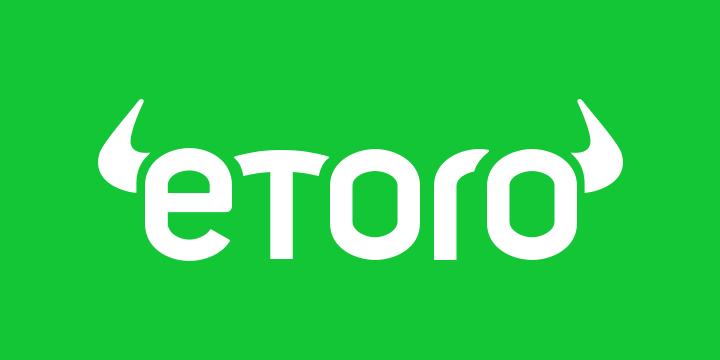
With cryptocurrency scams and theft of digital assets becoming a growing concern, people are turning to solutions that help them safeguard their crypto assets. While decentralized hot storage wallets are a good option, crypto cold wallets are the way to go if you want the best security possible.
This type of crypto cold storage wallet will keep your private keys offline on secure chips so that attackers cannot get a hold of them to spend your funds. But with so many wallets out there, how do you know which one to trust?
Our guide covers the best crypto cold wallets and offline wallet solutions we found in the industry. After testing several wallets, we have put together this list of cold storage wallets to guide you through selecting a suitable hardware wallet.
Best Cold Storage Crypto Wallets
1. Ledger Nano X – Best Overall Cold Storage Wallet
2. Trezor Model T – Best Touchscreen Digital Wallet
3. SafePal S1 – Most Affordable Wallet
4. Ledger Nano S Plus – Best Offline Storage
5. KeepKey – Best Inbuilt Exchange
Best Crypto Cold Wallets Compared
|
Wallet |
Cost |
Coin Support |
Features |
| Ledger Nano X |
£136 |
5000+ |
Bluetooth, Secure chip, Cross platform, NFT support |
| Trezor Model T |
£183 |
1450+ |
Touchscreen, Cross-platform, NFT support |
| SafePal S1 |
£42 |
3000+ |
Secure chip, slim and light, in-built camera |
| Ledger Nano S Plus |
£69 |
5000+ |
Cross platform, NFT support |
| KeepKey |
£42 |
100+ |
Large screen, Ergonomic design |
Our Top 5 Best Cold Storage Wallets for Crypto Reviewed
1. Ledger Nano X – Best Overall Cold Storage Wallet
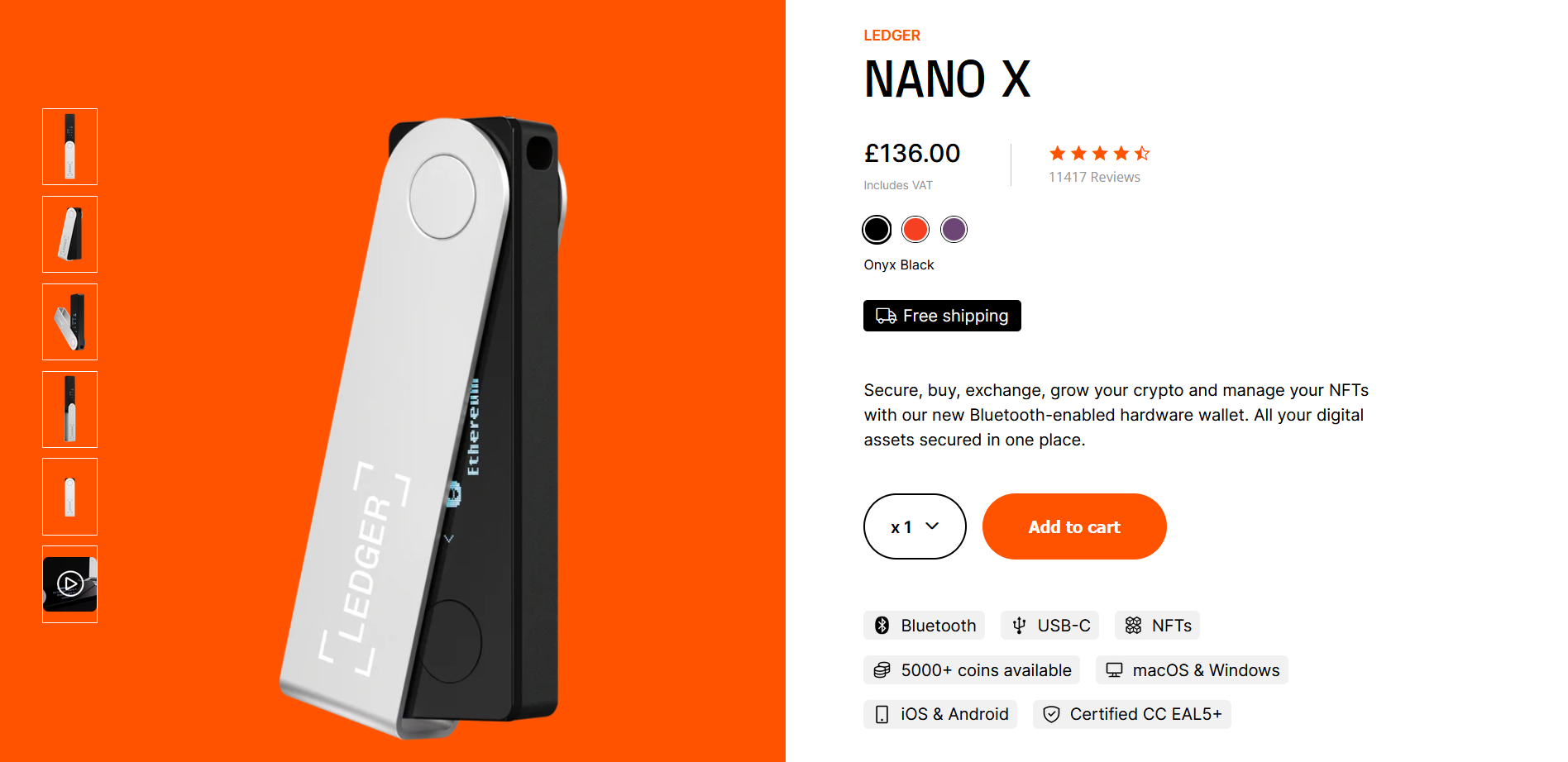
Ledger hardware wallets stand as industry leaders in cryptocurrency wallet hardware technology and their flagship device, the Ledger Nano X, is possibly the most secure offline wallet on the market. It is equipped with a secure offline chip, often called a secure element, and support for over 5000 crypto assets, including NFTs.
The cold storage wallet is accompanied by an application, called Ledger Live, that serves as a user interface. This application has desktop and mobile device versions that are quite intuitive. With the app, you can track your Ledger wallets portfolio, swap between coins, and use third-party services like a crypto-backed debit card.
The Ledger Nano X also comes with Bluetooth functionality that allows you to connect to your phone or computer wirelessly, although if you are big on enhanced security, you may want to stick with a non-wireless version (the Nano S Plus).
To begin using this Ledger hardware wallet, install the Ledger Live application on your phone or computer and load it. Click on “New Wallet and connect your hardware wallet to your device. Follow the prompts to create a new recovery seed phrase and pin for in case you lose access.
To store your digital assets, you need to install the blockchain applications on your wallet. Do this by going to the “Apps” section of the interface and installing the application for your chosen blockchain.
For example, if you want to deposit Bitcoin, you’ll need to first install the Bitcoin application to gain access. You will then be able to receive, send, store, and trade Bitcoin. You can also save NFTs, provided they are on blockchains supported by Ledger.
Ledger Nano X Pros
-
Top-notch security, even among hardware wallets
-
Intuitive interface
-
Helpful applications
-
Wireless connectivity
-
Wide crypto asset support
Ledger Nano X Cons
-
High exchange fees
-
Pricey
Ledger Nano X Features
The Ledger wallet comes Bluetooth enabled for wireless connectivity with phones and laptops, provided the Ledger Live application is installed. This feature allows you to take the secure storage out with you.
The wallet also supports third-party services, from a crypto tax tool to a crypto-backed debit card, to a service that lets you use crypto to recharge vouchers, to centralized markets like Binance. All this is accessible from the Ledger Live app.
Lastly, the desktop application features an in-built exchange that lets you swap between popular coins instantly.
2. Trezor Model T – Best Touchscreen Digital Wallet
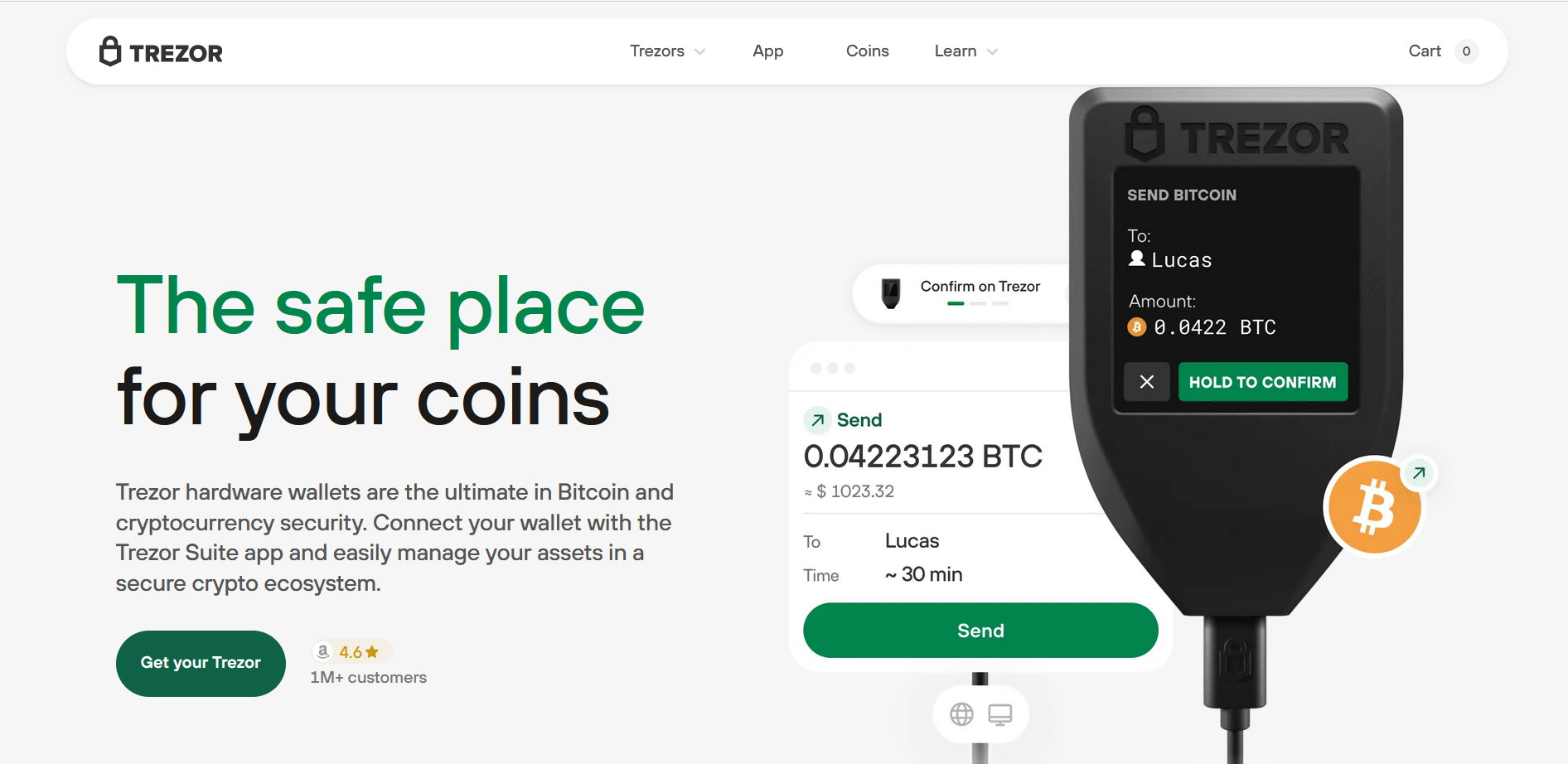
The Trezor Model T is a high-end hardware wallet that comes with a 1.5” color touchscreen LCD. It is a great option for investors who wish to maintain an extensive portfolio of cryptos and NFTs, as well as enthusiasts who wish to explore web3 in a secure way.
The wallet supports 1,456 crypto assets and comes with an in-built exchange to swap between coins. However, note that not all coins are eligible for swaps. Furthermore, you cannot store some digital assets like NFTs natively on Trezor. You can, however, use a third-party app to store and manage your tokens bought off of NFT marketplaces from the Trezor interface.
You can create an unlimited number of wallets within the device (theoretically, of course) and manage your coins in the Trezor Suite application.
Trezor takes security measures against accidental touches on the touchscreen panel by requiring a deliberation touch-and-hold action for transaction confirmation. The physical device is not connected to the internet, so all private keys stay offline.
To begin using the Trezor Model T, you’ll need to first update the firmware. Do this by connecting your device to your computer and navigating to the Trezor website on your browser. Click on “App” and select “Trezor Suite for Web”. Alternatively, you can download a Windows, Linux, or IOS client.
The website should give you instructions on how to update your Trezor firmware and create a new cold storage wallet. If you are a new user, you may want to stick with the Single-backup phrase option when creating a wallet.
Be careful when creating a new wallet. Trezor will only show you the backup recovery phrase once. Write them down on the recovery sheets of paper and keep them safe. To learn more, read our Trezor review.
Trezor Model T Pros
-
Secure offline storage
-
Extensive crypto asset support
-
Touchscreen
Trezor Model T Cons
-
Reports of USB-C port being sensitive
-
Form is not ergonomic
Trezor Model T Features
The Trezor Model T comes with a touchscreen that allows for easy navigation between applications. It also supports a wide range of crypto coins and tokens.
Lastly, the Trezor Suite App has MacOS, Windows, and Linux versions as well as a browser version.
3. SafePal S1 – Most Affordable Cold Wallet
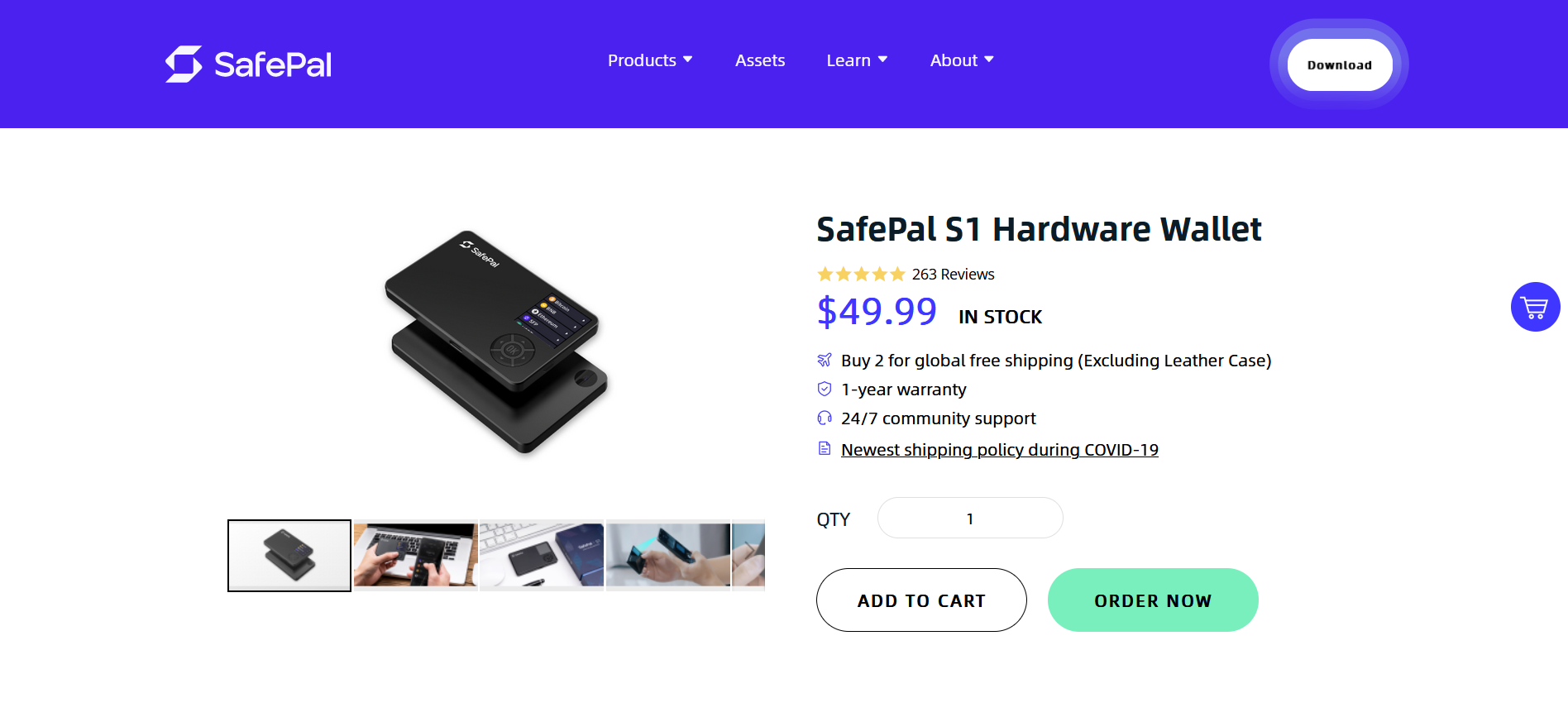
The Safepal S1 wallet is a slim and light hardware wallet that is shaped like a credit card. It comes with an inbuilt camera, a screen, and navigation buttons to help select blockchains, accept deposits, and authorize and conduct transactions.
While not as established as some other popular hardware wallets, SafePal has made a name for itself by creating a wallet that is completely stored offline. Unlike the Ledger Nano X which supports Bluetooth connectivity, there is no way to wirelessly connect to the SafePal hardware wallet.
When setting up your wallet for the first time, you’ll be able to choose between a 24, 18, or 12-phrase mnemonic phrase. This hardware wallet comes with a small card to write down your phrase. Once you have done that, set a password that will unlock your wallet after you buy Ethereum or other crypto, whenever you wish to use it, like a password for your mobile phone.
Next, download the SafePal mobile app and link it with the hardware physical device by scanning the QR code on the app with your wallet and vice versa. You can now use the wallet.
SafePal S1 Wallet Pros
-
Safe from online attacks
-
Navigation keys for easy use and analog authorization
-
Easy to configure
-
Portable and lightweight
SafePal S1 Wallet Cons
-
Does not work as a standalone wallet
SafePal S1 Wallet Features
The SafePal wallet features a secure element, which is an operating system on a tamper-proof secure element chip. It is used to guard against software and hardware attacks. The wallet is also battery-powered, making it a mobile-friendly wallet.
Lastly, the SafePal S1 comes with a camera that you can use to scan QR codes when sending money or making payments.
4. Ledger Nano S Plus – Best Offline Storage Solution

The Ledger Nano S Plus is a more toned-down hardware wallet in Ledger’s line-up of other hardware wallets. It is very similar to the Nano X in many ways, except for the wireless connection. This Ledger hardware wallet does not have Bluetooth functionality.
Similar to the Nano X, the S Plus comes in a rectangular form factor and is the size of a thumb drive. It has two buttons on the side, like volume keys, for navigation and manual authorization.
It also comes with a USB C adapter to connect to a computer or mobile phone. If your phone uses the micro USB port, you can get an additional USB cable adapter to connect to your cold storage at an extra charge.
Setting up the Nano S Plus is similar to the Nano X. Download the Ledger Live app, connect the device to your computer or phone, and follow the instructions to create a new cold storage wallet. As for security features, ensure you write your seed phrase on the cards provided and keep them safe. If you want to learn more, read our full Ledger Nano S review.
Ledger Nano S Plus Pros
-
Tight security
-
Extensive crypto support
-
Intuitive interface
-
Affordable
Ledger Nano S Plus Cons
-
High exchange fees
-
No support for Layer 2 assets
Ledger Nano S Plus Features
The Ledger Nano S Plus comes with portfolio management features that allow you view your entire portfolio, track them across time frames, and buy and swap between them easily thanks to the in-built exchange.
Thanks to the Ledger Live application, you also have access to third-party applications that provide a range of services like on-ramps, coin migrators, and even automated investment services.
5. KeepKey Wallet – Best Inbuilt Exchange
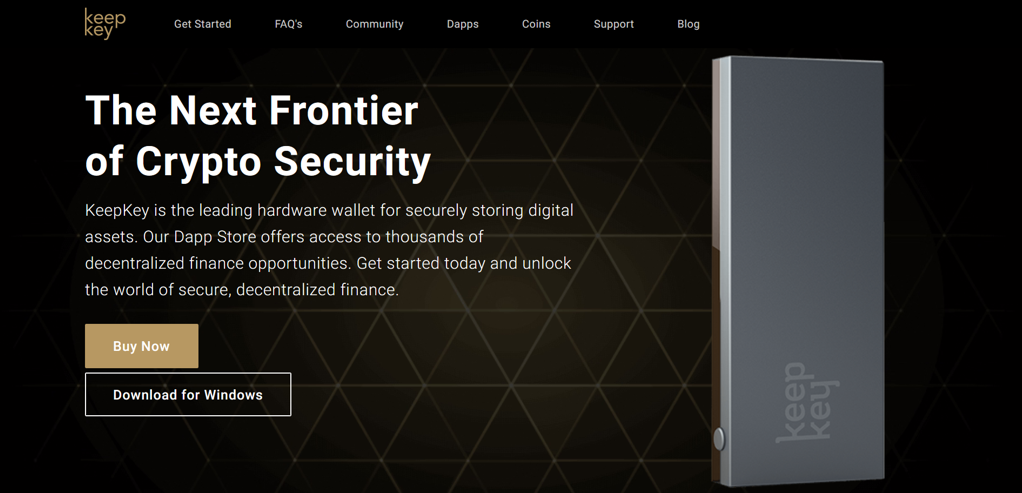
KeepKey wallet is a rectangular-shaped hardware wallet with a larger screen area than the other wallets on our list. The company was acquired by crypto exchange, ShapeShift, in 2017 and is a trusted choice for cold storage crypto wallets for many users.
KeepKey is a budget-friendly wallet at around $52 and is great for new investors who do not intend to maintain an extensive portfolio of coins or who use Bitcoin gambling sites. This value-for-money price is because the wallet makers made certain functionality cuts when developing this cold storage solution. One is coin support. KeepKey supports about 100 cryptos, staggeringly less than some of the other secure cold storage supported coins options on our list.
The wallet connects with popular web3 applications like Uniswap, Compound, OpenSea, Rarible, and even Unstoppable Domains using the Wallet Connect feature. Unfortunately, it does not connect to popular hot wallets like MetaMask, which is the most widely used software wallet in the industry.
Setting up your wallet also involves more steps than some other cold wallets as you’ll have to update your device’s firmware before being able to set up a wallet.
However, once your wallet is up, you have access to ShapeShift’s exchange interface from the wallet’s dApp. To learn more, read our KeepKey review
KeepKey Pros
-
Easy coin swap capabilities
-
Larger screen
-
Portable
-
Ergonomic form factor
KeepKey Cons
-
Limited crypto support
-
Limited web3 integrations
KeepKey Features
KeepKey is a cross-platform wallet that works with the MacOS, Windows, and Linux operating systems. It also has the wallet connect feature that allows you to connect with most decentralized applications.
Lastly, the wallet interface has a built-in exchange, thanks to its acquisition by ShapeShift. You get direct access to the exchange’s swap services as a native feature.
What is a Cold Wallet?
A cold wallet is a cryptocurrency wallet that stores a user’s private keys offline, effectively keeping them safe with additional protection from the clutches of security breaches from would-be attackers. And because your private key is needed to spend crypto, your coins are out of reach in long-term storage.
Cold hardware wallets are currently the safest crypto storage solutions on the market. They come as hardware physical devices, usually like a flash drive, small phone-like gadget, or a portable mifi-shaped device that can either be self-powered, like the Nano X, or powered by your computer, like the Ledger Nano S.
These wallets integrate with software to help deposit and withdraw coins as well as manage your portfolio. Their software can be native, like the Ledger Live, or third-party, like the MetaMask wallet.
A cold crypto wallet and cold storage go hand in hand. It is ideal for people in the crypto world who wish to hold onto their long term crypto they invested in.
How Does a Cold Crypto Wallet Work?
Cold wallets work on the principle of keeping private keys away from any device that has access to the internet and, as such, is vulnerable to online attackers.
Regular software crypto wallets usually store their private keys on the device’s hard drive or browser memory. These places aren’t the safest locations to store private keys as well-designed scripts could access the private keys on the browser tab, and malware could scan your computer or phone hard drive for private keys.
Cold cryptocurrency wallets, on the other hand, combine hardware and software to create a wallet to securely store your private key on a device that is always offline. They work just like a regular wallet but with additional security elements.
When setting up your cold wallet, you’ll generate a mnemonic phrase. Write it down and keep it safe because these seed phrases will be useful in recovering your wallet if you ever lose your device.
Once set up, you’ll have a public address, just like hot wallets, that you can use to receive crypto. Some wallets change this public address from time to time, like the Ledger Nano S hardware wallet, so ensure that you confirm the address each time you wish to deposit.
When you send crypto to your cold wallet address, the funds are kept safe as anyone trying to hack your wallet will need your private keys which are not online but are instead on a secure microchip in your cold wallet.
No keys, no digital assets to steal.
Key Things to Consider When Choosing a Crypto Cold Wallet
Security
The whole point of cold wallets is their added security benefits. Hence, a cold wallet with security threats and issues is a huge red flag to the crypto world.
Usually, security depends largely on the chip used which might make it tough for non-tech-savvy people to decipher who has the best hardware wallet. A way around this is to stick with wallets that have a track record of providing tight security.
For example, we haven’t heard of a scenario where any Ledger hardware wallets were hacked, and they are leaders in the cold wallet space, so they are a good choice.
User Interface
The user interface and resulting experience are important when it comes to how the crypto wallets work. While we expect a few extra steps that could create friction, at least when compared to hot wallets, these should not be extreme.
For example, when using the Trezor wallet, you’ll need to approve transactions for your crypto assets from the wallet by pressing and holding the digital buttons, which could take a while to get used to, especially for those acclimated to one-click hot wallets.
Coin Support
Coin support is important because the more coins a cold wallet supports, the better it can serve as your primary storage solution. Naturally, cold hardware devices have limited support compared to some hot wallets, due to security considerations. However, the major providers are constantly expanding their list of supported new cryptocurrency coins and networks.
Integrations
If you wish to carry out transactions directly from your hardware wallet device, then integration is an important factor to consider. For example, if you want to swap your coins on an Ethereum DEX, you’ll need to use another wallet interface.
A crypto wallet like MetaMask supports Ledger and Trezor integration. You can connect your cold wallet to MetaMask and then swap coins on a DEX, all while keeping your private keys offline. You can also stake, lend, and engage in yield farming strategies while keeping your private keys safe.
The more crypto applications your cold hardware wallet can securely integrate with, the more freedom you have to explore web3 while keeping your coins safe.
What Is the Main Difference Between a Hot Wallet and Cold Wallet?
Hot and cold wallets are similar in various ways. They both store cryptocurrency, have public and private keys, and use mnemonic phrases.
The only true way hot and cold wallets differ is where the user’s private keys are stored. Hot wallets store private keys somewhere on your device or with a custodian. It could be your hard drive or browser memory, while cold wallets store your private keys on a secure chip.
Because your device (phone or laptop) is generally using an internet connection, there is a risk of it being compromised and your private key being accessed. The secure chips that cold wallets use, however, are not connected to the internet and therefore cannot be breached by an online hacker with an internet connection.
Benefits of Using a Crypto Cold Wallet
The main benefit of using a cold wallet is the security and the peace of mind that it brings. You can use your cold wallet with confidence that it is not vulnerable to online hackers and other common crypto scams
Another benefit is the freedom to spend your crypto assets as you like. Custodial wallets, especially those associated with crypto exchanges, are beholden to rules that may not always be in your favor.
The companies that maintain these wallets can be subpoenaed or even sued by government agencies in countries they operate. Kraken was forced to shut down its staking program, essentially erasing a source of passive income for thousands, if not millions, of users.
With a cold wallet and a decentralized hot crypto wallet like MetaMask, you can stake on decentralized platforms that cannot be shut down due to government regulation. You are also not affected by withdrawal suspensions and losses due to bankruptcies.
Cold wallets allow you to invest in crypto just like you would with a hot wallet or even a custodial wallet. Some wallet applications, like the Ledger Live can connect to some crypto exchanges, like Binance to trade securely.
Final Thoughts on the Best Crypto Cold Wallets
We explored the best cold wallet crypto hardware on the market and picked Ledger Nano X as our top choice because of its industry-leading technology, Bluetooth connectivity, crypto asset support, and integration with popular crypto software.
However, all the best hardware wallets on our list are viable options for secure cold storage and will serve you well, depending on the features that are most important to you.
For example, if security is of the essence and portability is not a consideration, then the Ledger Nano S Plus will serve you well. If you’d like to carry around your device, although ill-advised, then the SafePal S1 will serve you well.
If you’d like to manage your crypto from a mobile phone, then the Ledger Nano X will best serve your needs, thanks to its Bluetooth connectivity.
Whichever wallet you choose, ensure that you back up your wallet by writing down your mnemonic phrase immediately when you set up the wallet. Keep this phrase offline at all times as storing it online and connected to the internet defeats the purpose of using offline storage.
Also, maintain more than one copy of your seed phrase in different locations to increase redundancy.
Methodology - How We Picked the Best Crypto Cold Wallets
The wallets covered in this guide were chosen through rigorous research and reviews. We paid attention to security, reputation, user experience, asset support, and competitive edge.
The wallets listed are the best we found in the various categories we listed them. For example, we listed Ledger as the best overall wallet because of the balance of security, asset support, interface, and integration.
Check out our why trust us and how we test pages for more information on our testing process.